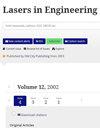A mathematical model to predict the thermal history and microstructure developed in laser surface alloying
IF 0.5
4区 工程技术
Q4 MATERIALS SCIENCE, MULTIDISCIPLINARY
引用次数: 9
Abstract
Laser surface alloying involves tailoring the surface microstructure and composition by rapid melting, intermixing and solidification of a pre/co-deposited surface layer with a part of the underlying substrate. It is a potential method of enhancing hardness and wear resistance of engineering components. In the present study, a one-dimensional heat transfer model based on the explicit finite difference method has been developed to predict the thermal history (i.e., temperature profile, thermal gradient, cooling rate and solid-liquid interface velocity) and hence, the microstructure of the alloyed zone developed by laser surface alloying. The incident laser power and laser-matter interaction time are chosen as the main variables to study the effect of laser parameters on thermal history, and consequently, microstructure of the alloyed zone. The numerical calculations have been carried out for the model system of AISI 304 stainless steel laser surface alloyed with pre-deposited molybdenum. The predicted resu...建立了一种预测激光表面合金化热过程和微观组织的数学模型
激光表面合金化包括通过快速熔化、混合和凝固预先/共沉积的表面层与底层基底的一部分来调整表面微观结构和组成。它是提高工程部件硬度和耐磨性的一种有潜力的方法。在本研究中,基于显式有限差分法建立了一维传热模型,用于预测激光表面合金化合金区的热历史(即温度分布、热梯度、冷却速率和固液界面速度),从而预测激光表面合金化合金区的微观组织。以入射激光功率和激光-物质相互作用时间为主要变量,研究了激光参数对合金区热历史的影响,进而对合金区的显微组织进行了研究。对aisi304不锈钢激光表面预镀钼合金模型系统进行了数值计算。预测的结果……
本文章由计算机程序翻译,如有差异,请以英文原文为准。
求助全文
约1分钟内获得全文
求助全文
来源期刊

Lasers in Engineering
工程技术-材料科学:综合
CiteScore
1.00
自引率
20.00%
发文量
0
审稿时长
3.4 months
期刊介绍:
Lasers in Engineering publishes original (primary) research articles, reviews, short communications and letters on all aspects relating to the application of lasers in the many different branches of engineering and related disciplines.
The topics covered by Lasers in Engineering are the use of lasers: in sensors or measuring and for mapping devices; in electrocomponent fabrication; for materials processing; as integral parts of production assemblies; within the fields of biotechnology and bioengineering; in micro- and nanofabrication; as well as the materials and processing aspects of techniques such as cutting, drilling, marking, cladding, additive manufacturing (AM), alloying, welding and surface treatment and engineering.
Lasers in Engineering presents a balanced account of future developments, fundamental aspects and industrial innovations driven by the deployment of lasers. Modern technology has a vitally important role to play in meeting the increasingly stringent demands made on material and production systems. Lasers in Engineering provides a readily accessible medium for the rapid reporting of new knowledge, and technological and scientific advances in these areas.
 求助内容:
求助内容: 应助结果提醒方式:
应助结果提醒方式:


